In today’s fast-paced world, helping children enhance their cognitive skills and overall development is more important than ever. One highly effective yet often overlooked method is Brain Gym—a series of simple physical movements designed to improve brain function. These exercises are particularly beneficial for kids, as they promote better focus, memory retention, and coordination, making learning more enjoyable and effective.
In this blog, we’ll explore:
- What Brain Gym is and why it’s essential for kids
- 10 powerful Brain gym activities for kids with step-by-step instructions
- The benefits of Brain Gym for children’s cognitive and physical growth
- How to access Brain Gym exercises PDF resources from Early Ed-ventures
What is Brain Gym?
Brain Gym is a series of simple physical activities that activate different parts of the brain, improving mental agility, concentration, and motor skills. It is based on the principle of educational kinesiology—using movement to enhance learning abilities.
Developed by Dr. Paul Dennison and Gail Dennison in the 1980s, Brain Gym exercises help integrate both hemispheres of the brain, promoting better coordination, memory, and emotional balance.
For children, incorporating Brain Gym into their daily routine can make learning easier and more fun, while also helping them manage stress and emotions effectively.
Benefits of Brain Gym Activities for Kids
Before we dive into specific exercises, let’s look at the wide-ranging benefits Brain Gym offers:
1. Improved Focus and Concentration
Brain Gym activities help activate the brain’s prefrontal cortex, enhancing children’s attention span and cognitive control. This is especially helpful for kids with ADHD or attention-related challenges.
2. Enhanced Memory and Learning
By stimulating different brain areas, Brain Gym promotes better memory retention and recall—key for effective learning.
3. Better Coordination and Balance
The exercises improve fine and gross motor skills, boosting physical coordination and balance. This also helps with handwriting, sports, and daily activities.
4. Reduced Stress and Anxiety
Brain Gym movements activate the parasympathetic nervous system, promoting relaxation and reducing feelings of stress or frustration in children.
5. Increased Confidence and Creativity
As children improve their cognitive and physical skills, they develop more confidence and become more creative in their problem-solving abilities.
10 Brain Gym Activities for Kids
Here are 10 easy and effective Brain gym exercises pdf you can try with children. These activities require minimal space and no special equipment—perfect for home or classroom settings.
1. Cross Crawl
Purpose: Enhances coordination, balance, and concentration.
How to Do It:
- Stand up straight.
- Touch your right elbow to your left knee.
- Then, touch your left elbow to your right knee.
- Repeat this motion for 1-2 minutes.
Tip: This exercise strengthens the connection between the brain’s hemispheres, boosting learning and memory skills.
2. Lazy 8s
Purpose: Improves eye-hand coordination and visual tracking.
How to Do It:
- Extend one arm and draw large figure eights (∞) in the air.
- Use your eyes to follow the motion without moving your head.
- Switch arms after 30 seconds.
Tip: This is a fantastic exercise for improving reading and writing fluency.
3. Brain Buttons
Purpose: Enhances brain alertness and attention span.
How to Do It:
- Place one hand on your navel.
- Use the other hand to gently massage the area between your collarbone and first rib (brain buttons).
- Massage for 20-30 seconds, then switch hands.
Tip: This exercise stimulates blood flow to the brain, increasing alertness and clarity.
4. Hook-ups
Purpose: Reduces stress and increases emotional balance.
How to Do It:
- Sit or stand comfortably.
- Cross one ankle over the other.
- Extend your arms, cross them, and interlace your fingers.
- Bring your hands to your chest and breathe deeply for 1-2 minutes.
Tip: This exercise is perfect for calming kids before exams or tests.
5. Double Doodle
Purpose: Improves fine motor skills and enhances creativity.
How to Do It:
- Give your child two crayons or pencils.
- Let them draw symmetrical shapes with both hands simultaneously.
- Practice for 5-10 minutes.
Tip: This activity activates both brain hemispheres and boosts artistic expression.
6. The Owl
Purpose: Improves attention and auditory processing.
How to Do It:
- Sit comfortably and place one hand on your opposite shoulder.
- Gently squeeze and release the muscle while turning your head in the opposite direction.
- Repeat on the other side.
Tip: This activity sharpens listening skills, making it ideal for young learners.
7. Energy Yawn
Purpose: Increases oxygen flow to the brain, reducing fatigue.
How to Do It:
- Place your fingers on your cheeks.
- Gently massage your jaw while yawning.
- Repeat 4-5 times.
Tip: This is a great activity to re-energize kids during long study sessions.
8. Think of an X
Purpose: Improves mental focus and reduces anxiety.
How to Do It:
- Ask the child to close their eyes and imagine a large "X" in their mind.
- Encourage them to breathe deeply and slowly for 1-2 minutes.
Tip: This visualization technique helps with emotional regulation.
9. Elephant Stretch
Purpose: Enhances balance and concentration.
How to Do It:
- Stand with feet shoulder-width apart.
- Extend one arm straight out, placing the opposite hand on the elbow.
- Rotate the extended arm in wide circles.
- Switch arms after 30 seconds.
Tip: This improves physical coordination and focus.
10. The Thinking Cap
Purpose: Boosts auditory and visual processing.
How to Do It:
- Gently massage the outer edges of your ears from top to bottom.
- Repeat for 30-60 seconds.
Tip: This is an excellent pre-reading or pre-listening activity.
How to Incorporate Brain Gym into Daily Routines
- At Home: Use Brain Gym as a warm-up before homework or creative activities.
- In School: Add Brain Gym breaks during lessons to enhance students' focus and productivity.
- During Play: Incorporate Brain Gym into outdoor games and physical activities.
Conclusion
Brain Gym activities offer a simple yet powerful way to improve children’s cognitive skills, coordination, and emotional well-being. By incorporating these exercises into their daily routine, parents and teachers can create a fun and effective learning environment.
For more Brain Gym activities, download the PDF from Early Ed-ventures and explore a variety of resources designed to support children’s holistic development.







Comments